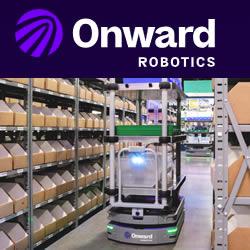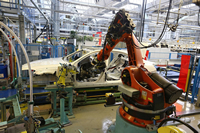Robotics, artificial intelligence fund has tripled the Dow this year
Evelyn Cheng for CNBC: Artificial intelligence, machine learning and robotics are making some real money for stock investors, and beating the market.
Robert Shiller: Fear of robots is driving the market rally
Alex Rosenberg for CNBC: "A theme that I have been coming back to is that the big worry that's on people's minds - I don't know how active it is in trading - but it's about where the world is going with automation and robotics,"
Have Robotics Stocks Gotten Too Hot?
Michael Kahn for Barron's: With the sector soaring, we found two smaller players - Cognex and Mazor Robotics - to keep an eye on.
Rise of the Robots
If manufacturers are going to flourish in America, they’ll need to buy a lot more robots. Here are six ways to play this hot trend.
Jack Hough for Barron's: For long-term investors, robots could be one key to securing healthy corporate profit growth, and stock returns, even as wages rise. There are specific opportunities, too. Japan’s Fanuc (ticker: 6954.Japan) is far and away the U.S. market leader in industrial robots, and it’s quickly ramping up production. Its shares have been outperforming, and they could offer 20% more upside over the next year. Germany’s Kuka (KU2.Germany), which sold a majority stake last year to China’s appliance giant, Midea Group (000333.China), has similar return potential. Other stocks with high exposure to industrial robotics and factory automation include Rockwell Automation (ROK), Switzerland’s ABB(ABB), and Yaskawa Electric (6506.Japan). And for one-stop shoppers, there’s the Robo Global Robotics & Automation Index exchange-traded fund (ROBO), which tracks 85 stocks, charges annual expenses of 0.95%, and has returned 37% over the past year. Cont'd...
Robotics-focused ETFs see big gains, Trump could hasten trend
Ryan Vlastelica for MarketWatch: If robots are taking jobs, should you invest in the robot makers?
That’s the argument behind a pair of outperforming exchange-traded funds that track the robotics industry, which could continue seeing strong growth as more positions get automated by machines or algorithms.
In a Jan. 23 note, UBS named automation and robotics as one of the two areas of technological innovation that would drive productivity over the coming decade, along with the digital data industry.
“Both have the potential to profoundly transform the structure of our economy, disrupt existing business models, but also create substantial growth opportunities for those well-positioned to participate,” the firm wrote, singling out the ROBO Global Robotics & Automation Index ETF ROBO, +0.59% as a fund that would benefit from this trend, with the investment time horizon of a decade. Cont'd...
A Robotics ETF Tries to Find its Way
Brenton Garen for ETF Trends: This year has seen another crowded field of new exchange traded funds come to market and within that group are plenty of niche funds, indicating that ETF issuers continue to slice and dice investment ideas into increasingly fine fund packages.
The Global X Robotics & Artificial Intelligence Thematic ETF (NasdaqGM: BOTZ) is one of those niche funds. BOTZ provides exposure to companies involved in the adoption and utilization of robotics and artificial intelligence (AI), including those involved with industrial manufacturing, medicine, autonomous vehicles, and other applications.
BOTZ follows the Indxx Global Robotics & Artificial Intelligence Thematic Index. The ETF, which debuted in September with the Global X FinTech Thematic ETF (NasdaqGM: FINX) and the Global X Internet of Things Thematic ETF (NasdaqGM: SNSR), holds 28 stocks with an average market cap of $8.8 billion, putting the ETF in mid-cap territory. Cont'd...
Records 1 to 6 of 6
Featured Product

Onward Robotics - Meet Me Fulfillment Automation
Meet Me uniquely brings talent and technology together: providing end-to-end process efficiency and enabling accurate and continuous fulfillment workflows. Proprietary Pyxis technology uniquely orchestrates picker and Lumabot AMR workflows independently, delivering fast, accurate, and efficient fulfillment from induction to pack out. Learn more about Meet Me Automation: Download Overview Brochure
Robotics and Automation - Featured Company

Zimmer Group US, Inc.
Are you interested in premium products in the fields of mechanical and plant engineering? Do you want to learn more about our solutions in the fields of automation, damping, linear, processing, tooling, and machine tooling technology?






